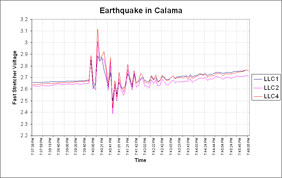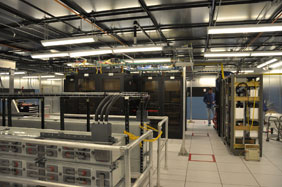NRAO eNews Volume 3, Issue 3 • April 6, 2010
Upcoming Events
 Cometary Radio Astronomy
Cometary Radio Astronomy
May 17–19, 2010 | Green Bank, WV
 Preparing for ALMA
Preparing for ALMA
May 24, 2010 | 6:00 - 8:00 PM EDT | AAS Meeting Special Session | Miami, FL
 NRAO Proposal Deadline
NRAO Proposal Deadline
June 1, 2010 | 5:00 PM EDT
 12th Synthesis Imaging Workshop NRAO & New Mexico Tech
12th Synthesis Imaging Workshop NRAO & New Mexico Tech
June 8–15, 2010 | Socorro, NM
Cometary Radio Astronomy: A NRAO Science Workshop
Jay Lockman and Anthony Remijan
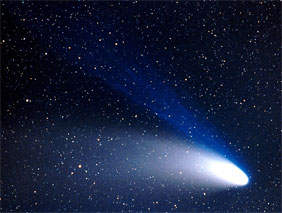
The astronomical community will soon benefit from an explosive growth in instrumental capabilities for cometary radio astronomy. The Expanded Very Large Array (EVLA) has initiated science operations, the first call for proposals for the Atacama Large Millimeter/submillimeter Array (ALMA) is expected in late 2010, and focal plane arrays will soon be available on the Green Bank Telescope (GBT) and the Large Millimeter Telescope (LMT).
Thus, a workshop on cometary radio astronomy is very timely and will be held in May 2010 at the NRAO research facilities in Green Bank, West Virginia. This workshop will bring together researchers to consider the science that these new instrumental capabilities will enable, to provide input into the development and operation of radio telescopes for cometary science, and to promote the importance of cometary research in the scientific portfolio of these facilities.
The workshop will begin with a reception on the evening of Sunday, 16 May 2010 and end with lunch on Wednesday, 19 May. Attendance is limited to ~ 40 persons by the Observatory logistics. Lodging will be provided on or near the NRAO facilities in Green Bank. There will be no registration fee. The NRAO will cover all meal and housing expenses and provide some transportation to Green Bank from airports in Charlottesville (CHO), Pittsburgh (PIT) and Washington, D.C. (IAD).
This meeting is organized by the NRAO and the Observatory’s Office of Scientific and Academic Affairs, and is supported by the North American ALMA Science Center, and the Center for Chemistry of the Universe of the University of Virginia Department of Chemistry. Additional information is available at the workshop's website.
Preparing for ALMA: A Special Session at the 216th AAS Meeting
Mark Adams and Al Wootten
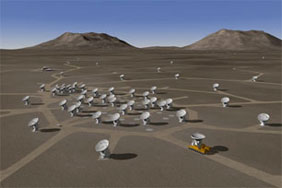
An artist's conception of ALMA in a compact configuration (image courtesy ESO).
A Special Session titled 'Preparing for ALMA' will be held on Monday, 24 May 2010, 6 – 8 p.m. EDT during the next summer meeting of the American Astronomical Society in Miami, Florida. The first call for ALMA observing proposals is expected in a little less than a year, while construction continues. This Special Session will describe the Early Science opportunity, as well as the ALMA tools and support available through the North American ALMA Science Center (NAASC) located at the NRAO headquarters in Charlottesville, Virginia. The NAASC staff will provide accurate and timely information on ALMA observing modes and capabilities to the community, support users creating proposals with the ALMA Observing Tool, staff an electronic Help Desk, validate observers’ scheduling blocks, and provide post-observation user support.
The Special Session will include an introduction to the major tools that users will to prepare their observations and analyze their data, including the ALMA Observing Tool (OT) for proposal preparation and submission, the Common Astronomy Software Applications (CASA) package that will be used to reduce ALMA science data and includes an “observing simulator” task, and Splatalogue, an on-line VO-queryable spectral line database.
During Early Science, ALMA is expected to include at least 16 antennas, 4 receiver bands, baselines to 0.25 km, and single field interferometry. Goals will include offering baselines to 1 km and single dish mapping of extended objects in continuum and spectral line modes. While Early Science will coexist with array commissioning, a portion of the available time will be allocated for science observations.
ALMA Construction Update
Al Wootten
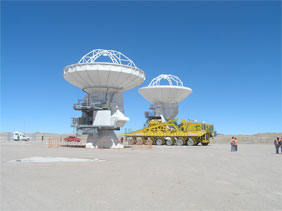
Figure 1: On 22 March, the DV01 ALMA antenna is moved into position alongside the PM03 antenna. PM03 had been moved the previous day to initiate the first ALMA array reconfiguration. Image courtesy: ALMA (ESO/NAOJ/NRAO), R. Hills (JAO)
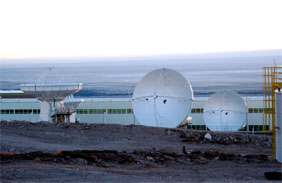
Figure 2: Four antennas undergo testing at the ALMA Operations Support Facility. On the right, ALMA antennas DV03 and DV05 begin a night of interferometric beam mapping. On the left, the newly accepted DV04 (foreground) and PM02 (background) antennas prepare for a night of pointing and holography. Image courtesy: ALMA (ESO/NAOJ/NRAO), A. Wootten (NRAO)
ALMA construction continues at full throttle after the Chilean earthquake that disrupted transportation within the country and caused a short delay. There was no damage to the ALMA facilities, which are located far north of the damaged areas. The people who comprise the ALMA team were of course affected, as many had friends, colleagues and family who were involved, and recovery for them continues.
Two ALMA antennas were moved on 21 and 22 March respectively to antenna stations within the cluster of stations designated for the Atacama Compact Array (ACA). Until 22 March, the ALMA antennas at the 16,500 foot elevation Array Operations Site (AOS) had occupied stations on baselines of ~ 150m and been operated on local generator power. This marks the first change of configuration for the fledgling array. The new baselines were determined in short order, aided by splendid weather at the site, with less than 0.5 mm precipitable water vapor. The shorter ~ 30m baselines on the ACA stations afford a more stable platform for many commissioning tests. Furthermore, a central power station is now available at the AOS for the antennas. A third antenna will be moved to an ACA station in early April. In its present location, 560m distant, it provides long baselines for other tests, such as water vapor radiometry.
At the lower-elevation Operations Support Facility (OSF), four ALMA antennas are being tested. Two of these are nearly through their hurdles and will join those at the AOS. The two antennas accepted several weeks ago are undergoing pointing and holography tests preparatory to being outfitted with the full retinue of ALMA equipment. Another front end arrived from the European Front End Integration Center (FEIC) in the U. K. and is undergoing its acceptance tests before being fitted into one of these antennas. Yet another front end assembly is expected from the East Asian FEIC in Taiwan in early April. A highlight of the period was the successful installation of the backup structure assembled at the AEM contractor’s facility at the OSF onto the mount structure. This marked the first integration of the major structural components of an AEM antenna, which make extensive use of carbon fiber. A second AEM antenna will have its major components mated within the next few weeks.
At midmonth, Mark McKinnon became ALMA North American Project Manager. He continues to work closely with Adrian Russell, who will remain North American Project Director until his departure to ESO this summer. Richard Prestage, Head of the Division of Technical Services (DTS) at the Joint ALMA Observatory in Chile, announced that he was returning to NRAO. Prestage, as first DTS Head, laid a solid foundation for the future of ALMA operations. Thijs de Graauw, ALMA Director said “Richard has made an invaluable contribution to the project so we are very sad to see him go.” De Graauw also announced a new interim organization for DTS.
ALMA Measures Calama Earthquake
Rodrigo Brito and Bill Shillue
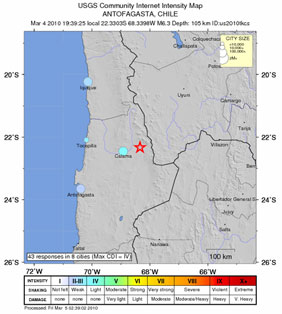
Figure 1: Earthquake data from the U.S. Geological Survey for the region near Calama, Chile, on 4 March 2010. The ALMA site is marked by the red star.
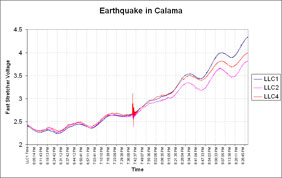
Figure 2: The ALMA Line Length Correction (LLC) Stretcher Voltages over the 3.5 hours centered on the earthquake. The generally increasing trend is due to outdoor temperature changes at sunset on the Chajnantor plateau. The fast stretcher voltage ripples on half hour timescales are due to indoor temperature changes. The system's earthquake response is the spike at center.
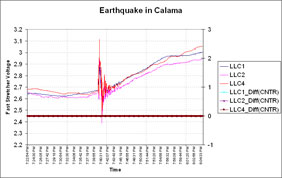
Figure 3: A closer view of the ALMA system's earthquake response. Three additional curves are associated with the plot's secondary axis (right). These are all flat at zero, demonstrating that the line length correcting system maintained the length stable to an accuracy of 0.007 millimeters.
On 4 March 2010, the ALMA system response to an extraordinarily large disturbance was measured when a magnitude 6.3 earthquake struck near Calama, Chile, relatively close to the ALMA site. Figures 1 through 4 demonstrate the remarkable performance of the ALMA system to a huge disturbance that was more than 100 times the specification for correction accuracy.
The ALMA telescope includes a Photonic Local Oscillator distribution system, in which each antenna is connected to a central building by optical fiber. The optical fiber is buried 1-m deep in the earth on the Chajnantor plateau in northern Chile. Due to the unprecedented combination of high observing frequencies (up to 950 GHz) and baselines up to 15 km, ALMA requires state-of-the-art precision in all of its instrumentation.
To provide the most accurate oscillator timing signals to the antennas, the approach adopted by ALMA uses a very accurate yardstick to probe the small changes in the fiber optic delay to each antenna. This is done via an ultra-stable “Master Laser” used in combination with an optoelectronic fiber optic line stretcher that continuously adjusts the overall fiber length to each antenna. This system corrects the timing for ALMA so that temperature changes and antenna motion effects are removed.
EVLA Project Update
Rick Perley and Joe McMullin
The EVLA met a major milestone with shutdown of the VLA correlator on 11 January. Work began immediately to reroute the fiber connections from the old correlator to the new WIDAR correlator. This major effort was completed by the end of January, enabling work to begin on bringing up the WIDAR correlator with all converted antennas available. Scientific observing with the WIDAR correlator and all available EVLA antennas started on schedule on 2 March.
Another major milestone was reached on 1 March when the last VLA antenna (EA10) scheduled for upgrade to EVLA standards entered the antenna barn. When this antenna rejoins the array in May, this major portion of the EVLA project will be completed, and all antennas will be available for testing and observing.
As advertised, early science observing with the WIDAR correlator is being done in one of two special Open Shared Risk Observing (OSRO) modes, modeled after the VLA correlator line and continuum modes, but with increased bandwidth and frequency resolution. The purpose of these modest initial modes is to allow continuation of existing VLA projects while the NRAO staff and visitors work on increasing the WIDAR correlator capabilities. This is a long and complex undertaking, but we believe that the expansion of capabilities for Resident Shared Risk Observing (RSRO) observations will meet the schedules advertised to our users. The observing program-level software systems have been in regular use since the start of science observations, including the Proposal Submission Tool (PST), the Observation Preparation Tool (OPT), the Observation Scheduling Tool (OST) and the Archive Access Tool (AAT). Refinements are ongoing to fully automate the operation/scheduling. Basic data quality assessments are being done on each data set during this early phase through the Common Astronomy Software Applications (CASA) and Astronomical Image Processing System (AIPS) post-processing packages.
While the buildup to the full WIDAR capabilities goes on, receiver development, deployment, and testing continue. Tests of the prototype Ku-band (12 –18 GHz) receiver have shown remarkable capabilities: total system temperature (mid-band) is 25K, which combined with an antenna efficiency of at least 60% provides an effective system temperature of 42K, making this band the most sensitive on the array to date. Outfitting of the remainder of the receivers has begun and will be completed by December 2010.
Tests of the new S-band (2 – 4 GHz) receivers also show excellent performance: system temperature of 30K, and efficiency of 53%. The final design prototype for the L-band (1 –2 GHz) receiver system has also been tested. Due to the undersized feed -- a consequence of the need to provide full frequency coverage from 1 to 50 GHz -- the efficiency is typically 45%, lower than other receiver bands. The system temperature is about 30K. These values apply from 1.2 to 2.0 GHz. This new system was designed to enable observations as low as 930 MHz, although with somewhat degraded sensitivity. The recent tests show that the effective system temperature rises from ~ 70K at 1.2 GHz to near 110K at 1.0 GHz, and 175K at 950 MHz. Full test results will be in the EVLA Memo series.
Deployment of new EVLA receivers at all bands continues according to schedule. The number of available, completed EVLA receivers is 5, 8, 21, 26, 20 and 24, at L, S, C, K, Ka, and Q-bands, respectively (Receiver Outfitting Schedule). Note that antennas not yet equipped with final design receivers at L and C bands can still observe in these bands but with a restricted tuning range.
Recent Press Releases
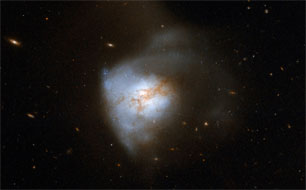
Astronomers Get Sharpest View Ever of Star Factories in Distant Universe (March 23, 2010)
Cambridge, MA - Astronomers have combined a natural gravitational lens and a sophisticated telescope array to get the sharpest view ever of "star factories" in a galaxy over 10 billion light-years from Earth. They found that the distant galaxy, known as SMM J2135-0102, is making new stars 250 times faster than our Galaxy, the Milky Way...
From the Archives
Ellen Bouton

Grote Reber was in Green Bank for a year in 1959-1960, overseeing the reconstruction of his original Wheaton antenna at the entrance to the NRAO site. During that same time, he was instrumental in arranging a collaboration between Bell Labs and NRAO to construct a working replica of Jansky's antenna at the Green Bank site entrance, although Reber had returned to Tasmania by the time it was installed. This photo of Reber with the Jansky antenna replica was taken by Ken Kellermann in 1995.
From the Archives is an ongoing series illustrating NRAO and U.S. radio astronomy history via images selected from our collections of individuals' and institutional papers. If readers have images they believe would be of interest to the Archives, please contact Ellen Bouton.
Career Opportunities
New Postings
Head of Technical Services: The Joint ALMA Observatory (JAO) invites applications for the Head of the Department of Technical Services of the Joint ALMA Observatory to join ALMA’s core management team. The successful candidate will contribute to strategic planning, policy development and implementation, as well as overall decision-making.
Technical Specialist II: The Electronics Division in Socorro, NM is seeking a Technical Specialist to assemble, calibrate, test, analyze, troubleshoot and/or repair the Digital Transmission System and Receiver modules.
EVLA Postdoc: The Expanded Very Large Array (EVLA) will begin offering Shared Risk Observing to the user community in March 2010. NRAO invites applications for an EVLA Commissioning Postdoc position which will be 50% independent research, and 50% assisting with the scientific commissioning of the EVLA. The successful candidate will help define observing procedures, test telescope performance, develop calibrator databases and calibration pipelines, and to assist with the development and testing of other hardware or software capabilities needed for the successful operation of the EVLA.
Software Engineer II (CASA Programmer): The Common Astronomy Software Applications (CASA) group has an immediate need for development of high-performance computing algorithms/packages and cluster environment support. The Software Engineer will develop high-performance computing algorithms/packages and cluster environment support.
Software Engineer III: The National Radio Astronomy Observatory in Socorro, NM is seeking a skilled developer to participate in the development of the observation scheduling and pipeline data-reduction subsystems. The successful candidate will display a strong working knowledge of Java and of object-oriented analysis and design. The ability to learn new computer techniques (languages, methodologies, etc.) quickly and independently is required. Excellent software technical documentation skills are required.
Software Engineer II: The Software Development Division in Green Bank, WV is seeking a Software Engineer to help design, develop, implement, and support the Dynamic Scheduling System for the Green Bank Telescope. The Dynamic Scheduling System is broken into three major components: a web application built with the Django web development framework, a series of custom user interfaces built with Ext GWT, and the core scheduler implemented in the functional programming language, Haskell. The Dynamic Scheduling team uses agile software development methods and automated unit testing to provide a working system for sponsors at every step of system development.
Software Engineer III: The Software Development Division in Green Bank, WV, is seeking a Software Engineer to provide support for the scientists who use the Green Bank Telescope (GBT). Work will be directed initially toward improvements in the post-observing data analysis and reduction software as well as developing data reduction and analysis software infrastructure for existing instrumentation.

 Zoom
Zoom